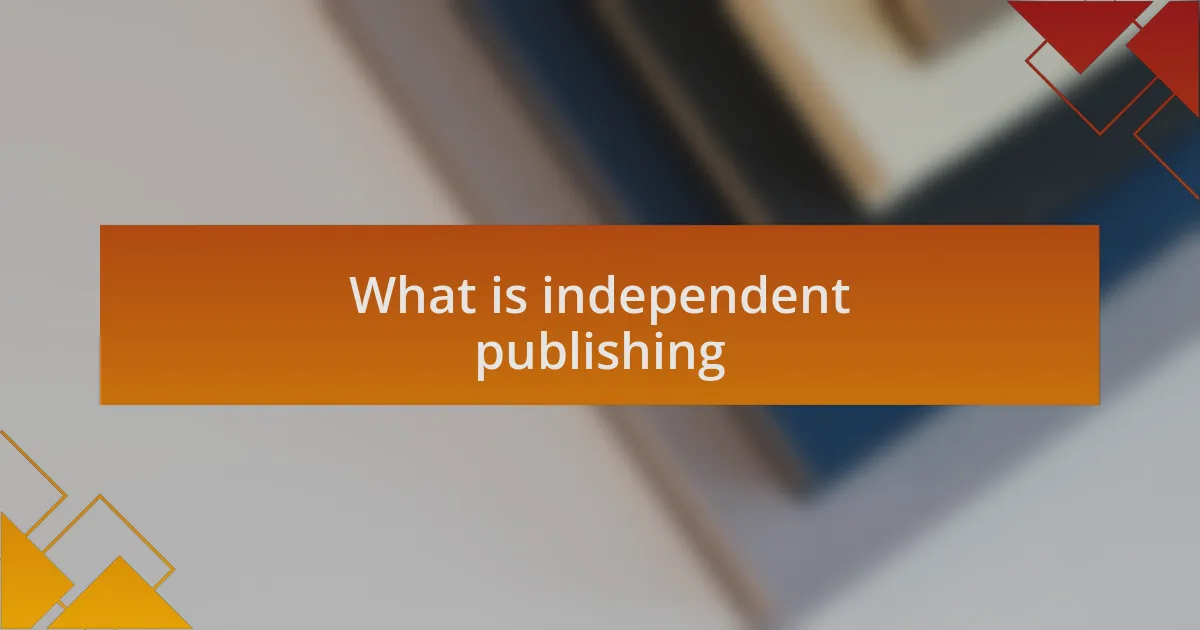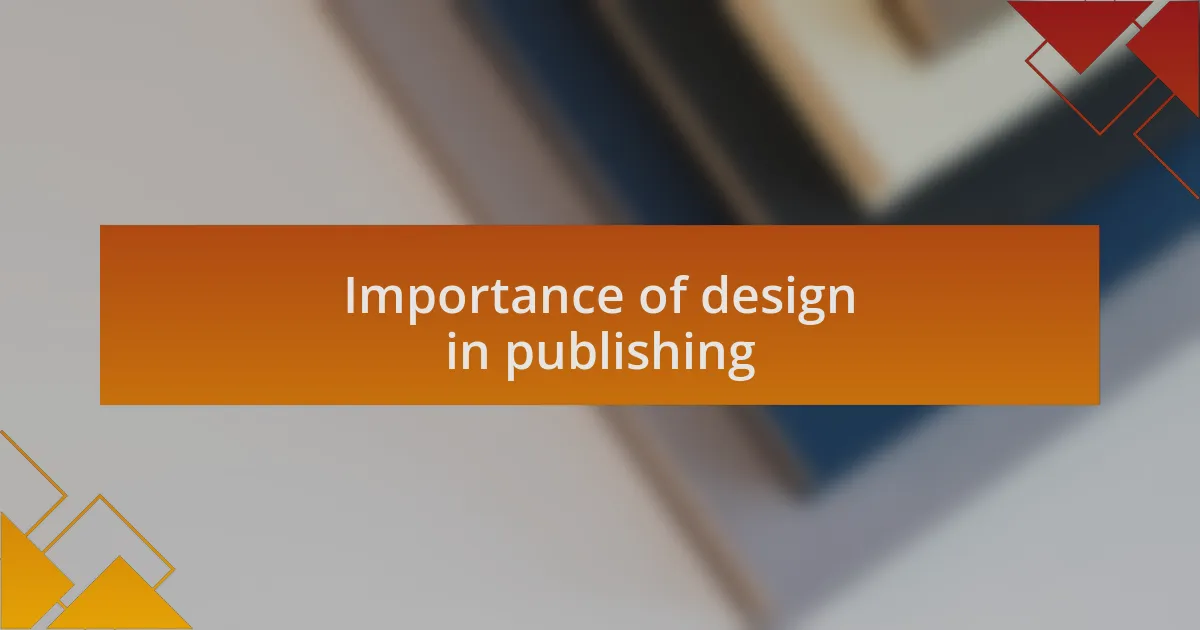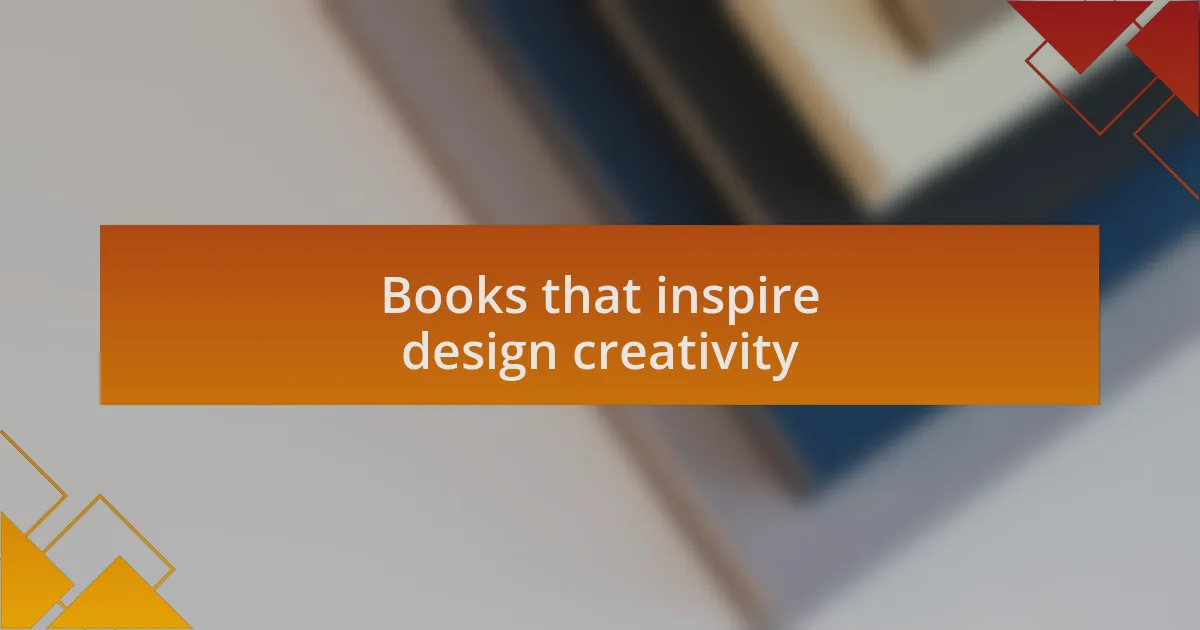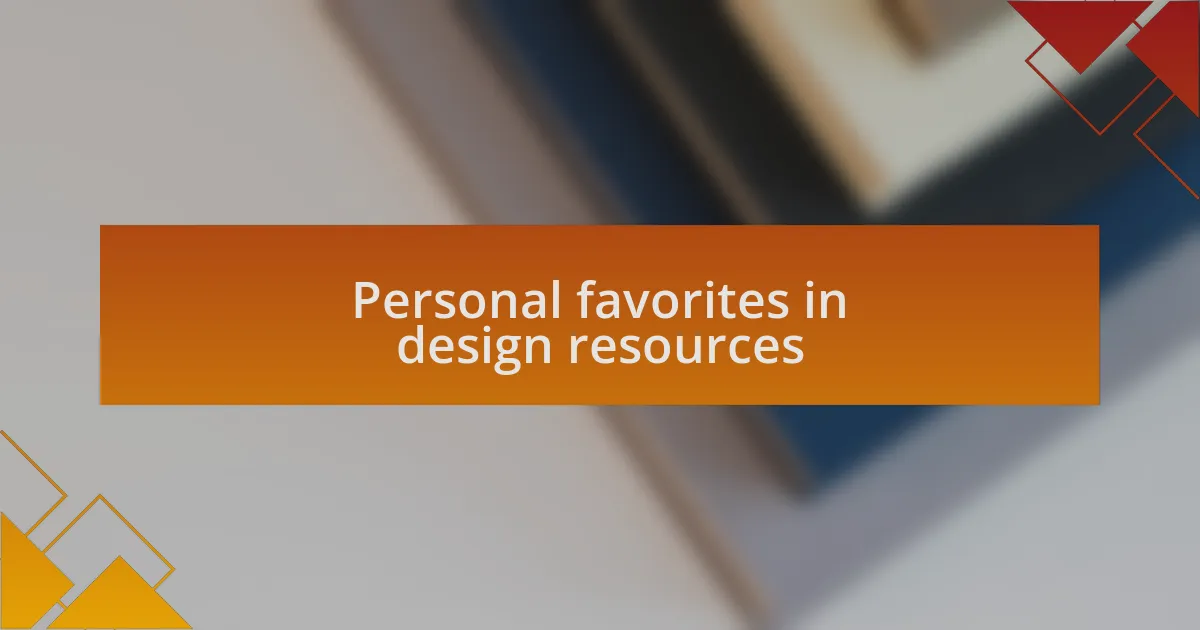Key takeaways:
- Independent publishing empowers authors by allowing creative control and fostering unique voices, challenging traditional publishing norms.
- Effective design is essential in independent publishing, enhancing reader engagement and providing a professional appearance that stands out.
- Key resources for design inspiration include platforms like Behance, Pinterest, and design blogs, which help creators discover innovative ideas and trends.
- Books such as “The Elements of Graphic Design” and “Steal Like an Artist” are vital for understanding design principles and fostering personal creativity.

What is independent publishing
Independent publishing is a practice that allows authors to retain creative control over their work, bypassing traditional publishing houses. I remember the first time I decided to self-publish my own book; it was empowering yet daunting. I had complete freedom to shape every detail, from the cover design to the marketing strategy. Isn’t it thrilling to think you can bring your vision to life without compromising?
Unlike mainstream publishers, independent publishing can be a more intimate approach, focusing on niche markets and unique voices. Each independently published work often tells a story of perseverance and passion, touching readers in ways that mass-produced titles might not. I often find myself drawn to indie authors who pour their hearts into their creations—there’s a distinct sense of authenticity that resonates deeply with me.
In many ways, independent publishing reflects the changing landscape of literature and creativity in our modern world. It challenges the status quo and invites diverse perspectives that might otherwise remain unheard. Have you ever considered how many incredible stories are out there, waiting to be shared by vibrant voices who dare to go their own way? That question is what fuels my appreciation for this dynamic medium.

Importance of design in publishing
Design plays a crucial role in the publishing world, especially in independent publishing. A well-thought-out design captures the essence of the story and connects with readers on a visual level. I remember meticulously selecting fonts and colors for my first cover, realizing that every choice sent a message about the content inside. Have you ever picked up a book just because the cover art spoke to you?
Moreover, effective design can elevate an independent book beyond its peers, giving it a professional appearance that stands out in a crowded marketplace. I often find that a striking layout not only attracts readers but also enhances their reading experience. It’s fascinating how a carefully designed page can draw the eye and encourage engagement. What design elements have caught your attention and made you dive deeper into a book’s narrative?
In today’s visually-driven culture, the importance of eye-catching design cannot be overstated. It serves not just as a reflection of the author’s vision but also as an invitation to readers. From personal experience, I’ve noticed that a beautiful cover can generate buzz and curiosity, leading to more discussions about the book. Isn’t it amazing to think that design can ignite conversations and build a community around a story?

Key resources for design inspiration
When searching for design inspiration, a few resources consistently stand out for me. Platforms like Pinterest allow me to curate and explore countless design ideas, sparking my creativity with just a few clicks. I often find myself lost in a sea of visuals, discovering color palettes or typography styles that resonate deeply with my personal aesthetic. Have you ever stumbled upon a design that seemed to ignite a new idea in you?
Another invaluable resource is Behance, where creative professionals showcase their projects in a beautifully organized space. It’s not just about viewing work; I appreciate how I can connect with designers and even follow their journeys. Engaging with their processes reminds me that design is often a collaborative effort. How often do you draw inspiration from the stories behind the designs?
Lastly, I love exploring the world of independent zines and art books. They often showcase unique design approaches that major publishers might overlook. Flipping through these tangible pieces lets me feel the texture of the paper and see how layouts work in the physical space. Isn’t there something truly special about holding a well-designed piece in your hands?

Online platforms for design ideas
One of my favorite online platforms is Dribbble, where designers share snapshots of their work. I often scroll through the latest designs for inspiration, and I can’t help but feel a rush of excitement when I see something that resonates with me. Have you ever experienced that moment when you find a design that perfectly captures your vision? It’s like a light bulb going off in your mind.
Another treasure trove is Instagram, especially when you follow the right accounts. I love discovering creative hashtags like #GraphicDesign or #TypographyLovers, leading me to unexpected gems. The way designers showcase their work in their feeds tells a story—an evolving narrative. I frequently pause to reflect on how a particular layout or color scheme can transform an entire concept. What story does your favorite designer tell through their posts?
Scrolling through design blogs, such as Design*Sponge or Creative Bloq, also fuels my creative fire. I appreciate how they highlight emerging trends while offering practical tips. There have been countless times when a simple directory post sparked a new idea for my own projects. How important do you think it is to stay updated with trends while still finding your unique style? For me, it’s about striking that balance—it pushes me to innovate while grounding me in what feels authentically me.

Books that inspire design creativity
When I delve into design books, I often find myself captivated by “The Elements of Graphic Design” by Alex W. White. This book doesn’t just teach the principles of design; it weaves together the history and theory behind every choice. I vividly remember a late-night reading session where a simple page taught me why space is as important as the graphics themselves. Have you ever had a moment where a book shifted your perspective? It’s a powerful realization.
Another favorite is “Steal Like an Artist” by Austin Kleon. Its honest approach to creativity resonates deeply with me; Kleon encourages embracing influences while finding your unique voice. I recall one instance when I applied one of his exercises—keeping a daily sketchbook—and it transformed my thought process. How has embracing your inspirations helped you grow as a designer?
Lastly, there’s “Graphic Design: The New Basics” by Ellen Lupton and Jennifer Cole Phillips, which has been a game-changer for me. This book breaks down essential design elements with clarity and fun visuals. On page after page, I felt like I was uncovering new ways to think about my work, particularly when they discussed color theory. Have you explored concepts that made you rethink your approach? I learned that every tiny choice can lead to a more cohesive design, which has stuck with me in every project since.

Personal favorites in design resources
One of my go-to resources for design inspiration is the website Behance. I often find myself scrolling through beautifully curated projects, and it never fails to spark new ideas. I remember discovering an innovative use of typography in an advertisement that instantly shifted how I approach text in my designs. Have you ever encountered a design that left you pondering its elegance long after you closed the page?
Another favorite of mine is Pinterest, where I can dive into a sea of visual ideas. I tend to create boards for different projects, gathering everything from color palettes to layout concepts. Recently, while assembling a mood board for an independent publishing project, I stumbled upon an unexpected combination of vintage and modern styles that fired up my creativity. Have you ever had a moment where a collection of images spoke to you?
Lastly, I can’t overlook the impact of design podcasts. “99% Invisible” has truly broadened my understanding of design in everyday life. In one episode, the discussion about the thought that goes into urban design led me to reassess how I approach community-focused projects. Isn’t it fascinating how design transcends the graphic and influences our experiences?